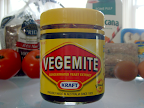Background
Australian breakfast is pretty similar to English and American breakfast, which makes sense given cultural background. I emailed several friends who were Australian and a cousin who had lived there, and they confirmed this as well.
I looked for books online to supplement my research, and I found lots of books on Australian food, including one specifically dedicated to breakfast. Thanks to the World Catalog website I was able locate many of these books. They were all in Australia.
The basic menu is going to be the sausage we made a couple of weeks ago. In addition to that we are going to have fried mushrooms, tomatoes, poached eggs, and toast. On the toast we will have the ingredient that will mark is as Australian: Vegemite. Vegemite is a dark brown spread made from yeast extract left over from brewing beer.
 My first experience with vegemite/marmite was in New Zealand. My sister told me it was really good and to pile it up my toast. I had no idea what it would taste like and it was really strong and I spit the toast out. I have been a little wary of the stuff ever since. Kitty's first experience was on a train with some Australians while touring in Asia. They told her to take a bite with the secret expectation she would find it gross. She liked it, to the great disappointment of her traveling companions. (Nothing grosses you out after sannakji. –Kitty)
My first experience with vegemite/marmite was in New Zealand. My sister told me it was really good and to pile it up my toast. I had no idea what it would taste like and it was really strong and I spit the toast out. I have been a little wary of the stuff ever since. Kitty's first experience was on a train with some Australians while touring in Asia. They told her to take a bite with the secret expectation she would find it gross. She liked it, to the great disappointment of her traveling companions. (Nothing grosses you out after sannakji. –Kitty)The beverages are juice and coffee or tea. A drink called the flat white is a local variation on cafe latte that uses the microfoamed milk. Some people claim it is not any different from cafe latte and others that it was created in New Zealand. In any case, it was very hot the morning we had this breakfast and we decided to go for the juice.
Breakfast Fry
Like the English breakfast, grease management will be important here. We are fortunate to have a jar of bacon fat leftover from making homemade bacon. I will show how to cure bacon at a future date, but rest assured it is both awesome and easy.
- Bacon grease
- Sausage
- Mushrooms
- Tomatoes
- Heat a flat bottomed pan over medium low heat and add enough fat to thinly cover the bottom.
- Add the sausages to the middle of the pan.
- Add the mushrooms around the sausage.
- Let the mushrooms brown by letting them sit still and occasionally checking their color. Flip side when they have sufficiently browned.
- Turn the sausages regularly to brown all sides and let them cook evenly.
- When the mushrooms are done remove them from the pan.
- Remove the sausages, cut them lengthwise, and cook the inside part face-down in the pan. This gives them a nice color and looks good in presentation.
- Cut the tomato in half, remove the core and fry the halved cut-side-down in the greased pan. Add more grease to the pan if necessary.
Poached Eggs
- Eggs
- Salt
- Silicone egg poacher (optional)
- Bring water to a boil in a pan large enough for the poachers to float freely.
- Crack each egg into an individual poacher, if using.
- Place the eggs/poachers into the boiling water, cover, and simmer for 7 minutes.
- Remove from molds and season with salt, pepper, and dill
Toast with Vegemite
- Spread a layer of soft butter onto your toast.
- Spread a thin layer of Vegemite over the butter.
Results and Discussion
The sausage was excellent. The the sage and ginger give it a light taste which is a great contrast to the dense sausage texture. The mushrooms and tomatoes came out really well. The bacon grease did a great job browning the mushrooms and cooking the tomatoes.
I found the Vegemite much more palatable this time. The major change is that there was much less of it. Vegemite has a very strong taste and is quite salty. I was trying to think of a taste to compare it to and I could not think of anything. Kitty pointed out that is probably closest to miso and I agree with her. The butter mellows the Vegemite a bit and rounds out the flavor. I am less scared of Vegemite now that I have had it in proper proportions.







